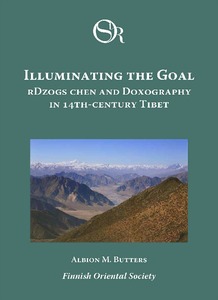Illuminating the Goal: rDzogs chen and Doxography in 14th-century Tibet
Albion M. Butters
https://urn.fi/URN:NBN:fi-fe2021042822193
Tiivistelmä
This study explores the philosophical, canonical and doxographical
contributions of one of Tibet’s greatest thinkers, Klong chen rab
’byams pa (1308–1363), or Longchenpa, particularly as presented in his
detailed overview of Buddhist tenet-systems, the Grub mtha’ mdzod (The
Precious Treasury of Spiritual Systems). While the bulk of the previous
scholarship on this scholar has focused almost exclusively on his
writings on the tantric modality of Atiyoga (or rDzogs chen), this study
addresses Klong chen pa’s endeavors to integrate that school of thought
with the other Buddhist vehicles (Sūtrayāna and Mantrayāna) by means of
parallel techniques and a polysemic hermeneutic. Furthermore, it
questions a number of critiques brought against rDzogs chen.
Furthermore, by locating Klong chen pa biographically and textually in
relation to the other seminal figures of 14th-century central Tibet
(e.g., Bu ston, O rgyan gling pa, Dol po pa), this study shows the
precise nature of his wide-ranging contributions to canonical
construction within the rNying ma tradition of Tibet and the
particularities involved with his interpretation of Buddhism’s
two-reality theory (relative and ultimate) in relation to the
Svātantrika and Prāsaṅgika schools of Madhyamaka philosophy. In the
process, it provides context for understanding Klong chen pa as a
complex figure, with both scholarly and practical soteriological
concerns, and his engagement with the most critical debates of his time.
Kokoelmat
- Rinnakkaistallenteet [19207]
